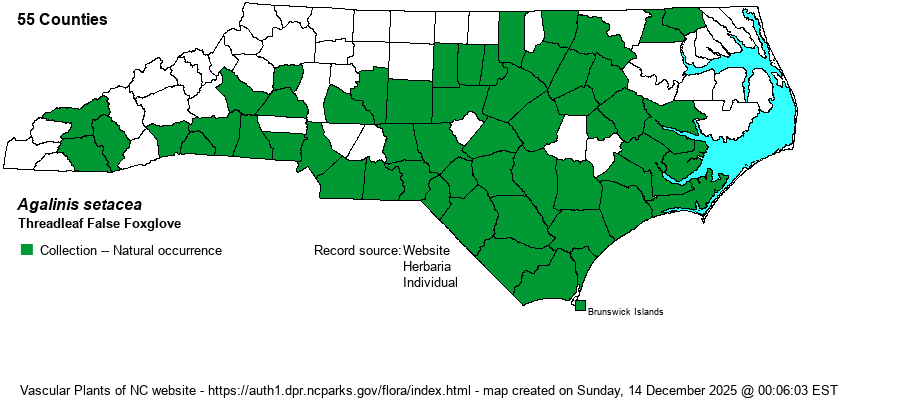| Author | (J.F. Gmelin) Rafinesque | |
| Distribution | Present over most of the southern 2/3rds of the Coastal Plain and Piedmont, and also in the southern Mountains. Absent or very rare in the northwestern portions of the state, including much of the Piedmont, and also seemingly absent in the northeastern Coastal Plain.
This is a Southeastern species, ranging north to Long Island, NY, and south to central FL and west to MS. It is as numerous in the Carolinas as anywhere else. | |
| Abundance | Common in the Sandhills and other sandy places to the east, to about Onslow County. Fairly common in the central Coastal Plain, but rare to uncommon in the northern portions. In the Piedmont, fairly common in the southeastern portions, but uncommon in the northeastern and central areas, and rare in the far southwestern Piedmont and southern Mountains. | |
| Habitat | This is the "sandy soil" Agalinis in NC, being found most often in xeric pine/scrub oak sandhills, sandy roadsides, sand rims of bays, dry and often sandy roadbanks, and less often in dry and open woodlands. | |
| Phenology | Blooms in September and October, and fruits in October and November. | |
| Identification | This is a small to medium herb, growing to about 1 foot tall, with a number of spreading branches from the upper part of the stem. The numerous leaves are opposite, but linear and extremely narrow, about 1-1.2 inches long. Thus, despite the many leaves and branches, it is a slender and delicate-looking plant, with smooth stems. At the ends of the branches grow the flowers in short racemes, but in this species each flower is on a fairly long stalk, often 2/3-1-inch long. The flower is bright rose-colored, with 5 lobes and with an open face/mouth, facing upward, about 3/4-inch across. It is generally easily separated from other Agalinis species by the long flower stalks, much longer than the calyx tube; only A. tenuifolia has such long stalks, but its flower is hooded, with the upper corolla lobes bent down nearly covering the mouth. The flowers are larger and more bright rose in this species than in A. obtusifolia and A. decemloba, but they average smaller and more open-faced than the larger and more forward-facing flowers of A. purpurea (a more robust plant). In the fall, this plant can be common enough in colonies to provide a very pleasing rose color to your walk in the Sandhills and other sandy places. Some Coastal Plain roadsides can be colored rose with the blooming plants in the fall, easily noted from your moving vehicle. | |
| Taxonomic Comments | None
| |
| Other Common Name(s) | Threadleaf Gerardia | |
| State Rank | S4 [S4S5] | |
| Global Rank | G5? | |
| State Status | | |
| US Status | | |
| USACE-agcp | | |
| USACE-emp | | |

